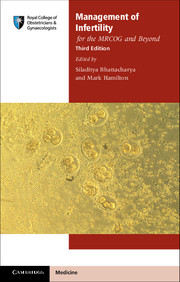Book contents
- Frontmatter
- Contents
- About the authors
- Preface
- Acknowledgements
- Abbreviations
- 1 Epidemiology and initial assessment
- 2 Male factor infertility
- 3 Ovulatory disorders
- 4 Tubal infertility
- 5 Endometriosis-related infertility
- 6 Uterine factors in infertility
- 7 Unexplained infertility
- 8 Assisted reproduction – preparation and work-up of couples
- 9 Assisted reproduction – clinical and laboratory procedures
- Index
8 - Assisted reproduction – preparation and work-up of couples
Published online by Cambridge University Press: 05 June 2014
- Frontmatter
- Contents
- About the authors
- Preface
- Acknowledgements
- Abbreviations
- 1 Epidemiology and initial assessment
- 2 Male factor infertility
- 3 Ovulatory disorders
- 4 Tubal infertility
- 5 Endometriosis-related infertility
- 6 Uterine factors in infertility
- 7 Unexplained infertility
- 8 Assisted reproduction – preparation and work-up of couples
- 9 Assisted reproduction – clinical and laboratory procedures
- Index
Summary
Introduction
This chapter addresses the issues related to patient selection and preparation prior to undergoing assisted reproductive technology (ART) techniques, and the role of regulatory control in ART and welfare of the child assessment. Special aspects of ART including gamete and embryo donation, pre-implantation genetic screening (PGS) and diagnosis (PGD) and fertility preservation are also discussed.
Prognostic factors and patient selection
Age of the female
A woman's age is probably the most significant predictor of successful outcome, and the chances of a live birth after IVF treatment vary considerably with age. The optimal age range for treatment is 23–39 years, with the highest live birth rates being in women under the age of 35 years.
The National Institute for Health and Care Excellence (NICE) fertility guidelines recommend offering three full treatment cycles of IVF to women younger than 40 years who have not conceived after 2 years of regular unprotected intercourse. The use of IVF beyond the age of 40 years is associated with a reduction in the chance of conception and health economic considerations may make the proposition of funding treatment less attractive to those holding budgets for care. Figure 8.1 shows the influence of female age on live birth rates after IVF in the UK.
Duration of infertility
The duration of infertility is also a major factor in determining the likelihood of spontaneous pregnancy. Evidence suggests a significant decrease in age-adjusted live birth rates with increasing duration of infertility between 1 and 12 years.
Keywords
- Type
- Chapter
- Information
- Management of Infertility for the MRCOG and Beyond , pp. 85 - 96Publisher: Cambridge University PressPrint publication year: 2014

